Chapter 4 Theory of Firm Under Perfect Competition
Pick the odd one out and justify your answer
- Free entry .
- profit maximization .
- perfect knowledge .
- price discrimination .
- Homogneous product
- freedom of entry and exit
- large number of buyers and sellers
- product differentiation
- MC = MR
- MR = AFC
- MC cuts MR from below
- P = AC
- Homogneous products
- free entry and exit
- price maker
- price taker
Answer:
D. Price discrimination . Others are features of perfect competition
Answer:
D. Product differentiation . Others are features of perfect competition .
Answer:
B. MR = AFC . Others are conditions for firm’s equilibrium under perfect competition
Answer:
C. price maker
Multi choice questions
- Profit of a firm is the revenue eamed :
- zero of cost
- gross of cost
- net of cost
- None of these
- TMC curve cuts LAC curve :
- at minimum point
- at maximum point
- below the LAC curve
- None of these
- Under perfect competition , firm is :
- price maker
- price taker
- both ( A ) and ( B )
- None of these
- MR can be negative but AR is :
- negative
- positive
- either positive or negative
- None of these
- A fall in supply caused by a fall in price is known as:
- Contraction of supply
- Expansion of supply
- Increase in supply
- None of these
- Which one of the following condition is not satisfied by the long run equilibrium of a firm under perfect condition ?
- P = AR
- AR = MR
- MC = MR
- AFC = AVC
- When supply curve is a vertical straight line , supply is
- Perfectly elastic
- Perfectly inelastic
- Unitary elastic
- None of the above
- )The price under perfect competition during the short run should be at least equal to
- Short run MC
- Short run AC
- Short run AVC
- TC
- Long run price under perfect competition will be equal to
- AC
- MC
- TC
- FC
- Maximum price fixed for a product by the goverment is called
- Floor Price
- Price Ceiling
- Rationing Price
- None of these
- The point denoted by the minimum of AVC is called
- Shut down point
- Normal Profit
- Break even point
- All of the above
- Firm is price taker under :
- Perfect competition
- Monopoly
- Dopoly
- Oligopoly
- Identify the equilibrium condition of a firm under perfect competition .
- AC = MR , & AC cuts MR from above
- MC = MR , & AC cuts MR from below
- MC = MR , & MC cuts MR from above
- MC = MR , & MC cuts MR from below
- The demand for the product of a firm is perfectly elastic in one of the following markets . Identify the market .
- monopoly
- oligopoly
- perfect competition
- monopsony
- Which of the followings represent normal profit ?
- MR = MC
- TR > TC
- AR = AC
- A < AC
- Shut down point occurs at
- following part of AVC
- minimum point AVC
- rising part of AVC
- None of the above .
- A firm is able to sell any quantity of the good at a given price . The firm’s marginal revenue will be
- Greater than AR
- Less than AR
- Equal to AR
- Zero
- The short run shut – down point of a firm in a perfectly competitive firm is
- P = AVC
- P = AC
- p > AVC
- p < AVC
- If P exceeds AVC but is smaller than AC at the best level of output , the firm in perfect competition is
- Making profit
- Minimizing losses in the short run
- Incurring a loss and should stop producing
- Breaking even
Answer:
C. net of cost
Answer:
A. at minimum point
Answer:
B. price taker
Answer:
B. positive
Answer:
A. Contraction of Supply
Answer:
D. AFC = AVC
Answer:
B. Perfectly inelastic
2 ) 3 )
Answer:
A. AC
Answer:
C. Short run AVC
Answer:
B. Price Ceiling
Answer:
D. All of the above
Answer:
A. Perfect competition
Answer:
D. MC = MR , & MC cuts MR from below
Answer:
C. perfect competition
Answer:
C. AR = AC
Answer:
B. minimum point AVC
Answer:
C. Equal to AR
Answer:
A. p = AVC
Answer:
B. Minimizing losses in the short run
State whether the statements are true or false .
- In a perfect competitive market structure , firms are price takers . Answer:
- All firms in the market produce homogeneous product Answer:
- A perfectly competitive market deals in heterogeneous product . Answer:
- Each buyer under perfect competition is a price taker . Answer:
- A perfectly competitive market is a market where there is only a single seller . Answer:
True
True
Wrong . A perfectly competitive market deals with homogenous products .
Wrong . Each seller under perfect competition is a price taker .
Wrong . A monopoly market is the market where there is only a single seller .
Answer the following questions
- A firm cannot make super normal profit in the long run under perfect competition . Do you agree ? Substantiate your answer . Answer:
- Define ‘ Break even point ‘ . Answer:
- Examine the difference between the short run price and the long run price of a firm under perfect competition . Answer:
- What is the supply curve of the firm in the long run ? Answer:
- How does technological progress affect the supply curve of the firm ? Answer:
- How does an increase in the number of firms in a market affect the market supply curve ? Answer:
- Define ‘ shut down point ‘ Answer:
- Make pairs
Perfect competition , price marker , oligopoly , Cournot model , price taker , monopoly .
Answer: - The diagram below shows two curves faced by a firm under perfect competition . Name them .
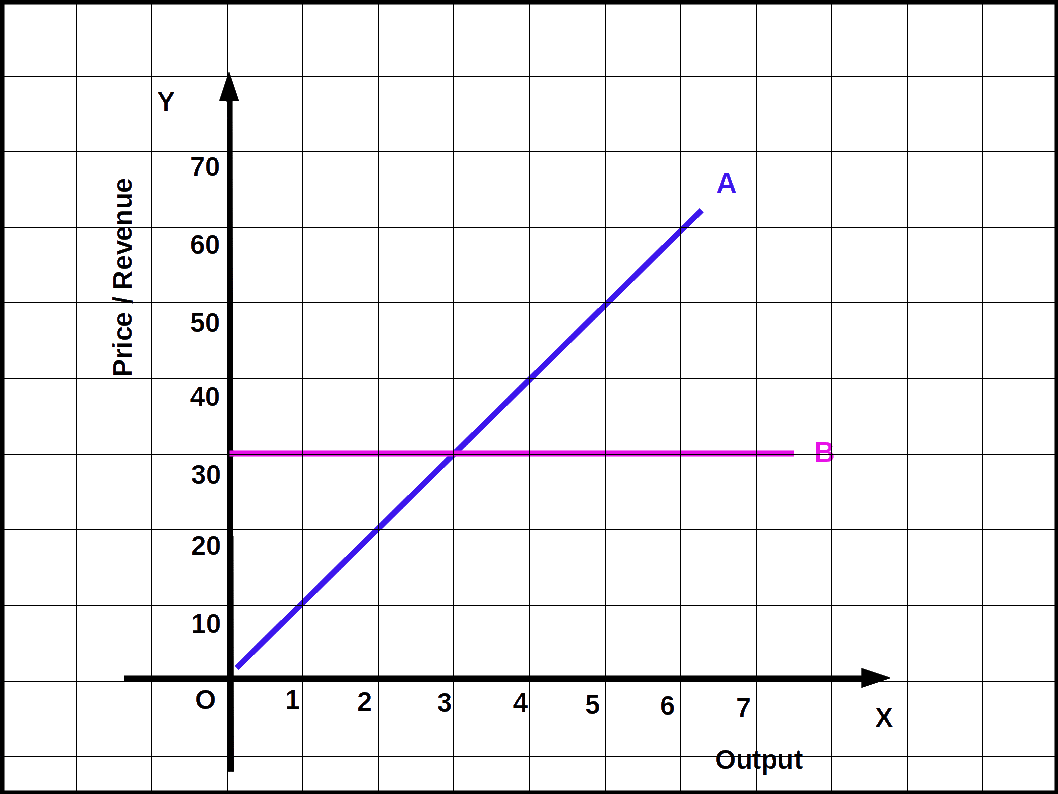 Answer:
Answer: - Match the following .
Table 4.2 A B Perfect Competition TR – TC TR Minimum point of AVC Profit Price Taker Shut down point Price × Quantity Supply curve of the firm Rise in unit tax Shift of supply curve Rising portion of SMC
Answer: - A firm maximizes profit when the difference between total revenue and total cost is the maximum . Profit is maximized when certain conditions are satisfied . Do you agree ? Answer:
- a ) The market price , p , is equal to the marginal cost .
- b ) The marginal cost is nondecreasing .
- c ) In the short run , the market price must be greater than or equal to the average variable cost . In the long run , the market price must be grater than or equal to the average cost .
- Write the economic terms
- a ) Cost vary with output
- b ) Total Cost divided by quantity
- c ) TRn – TRn-1
- d ) TR = TC point
- e ) A case where an increase in all the inputs lead to a just proportionate increase in output .
Answer: - a ) Variable Cost
- b ) Average Cost
- c ) Marginal Revenue
- d ) Break Even Point
- e ) Constant Returns
- Perfect competition does not exist in the real world . Do you agree ? Substantiate your view . Answer:
- A firm’s supply curve in the short run is the rising part of the SMC curve . Why ? Answer:
- Imagine that Sº is the original supply curve of the firm . If a unit tax is imposed , what happens to the supply curve ? Show the change in a diagram . Answer:
- List the factors affecting elasticity of supply . Answer:
- a ) nature of the commodity
- b ) cost of production
- c ) time period
- d ) technique of production
- Observe the following figures and answer the questions .
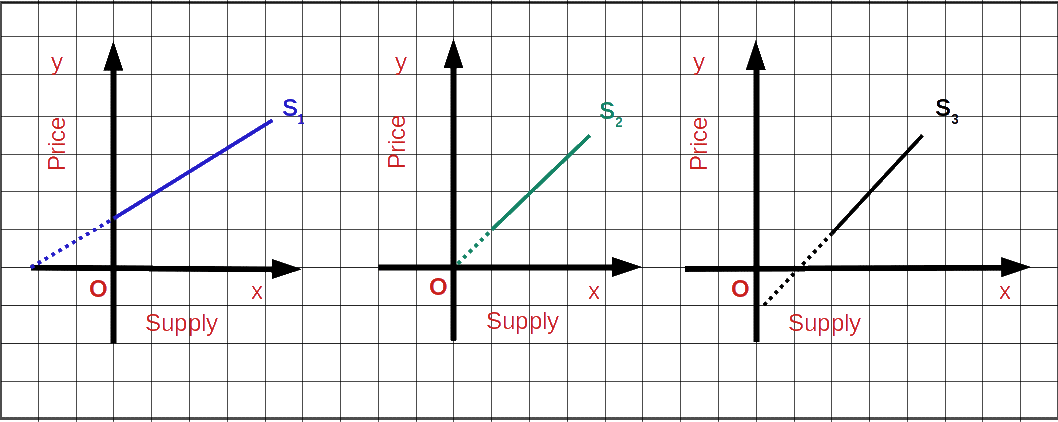
- i ) Point out the elasticities on the above supply curves .
- ii ) Which method is applied here .
Answer: - i ) S1 Elastic supply S2 Unitary elastic supply S3 Inelastic supply
- ii ) Geometric method is applied here .
-
- a ) Identify the market structure that is represented by the AR curve in the diagram .
- b ) Explain why the AR curve is horizontal
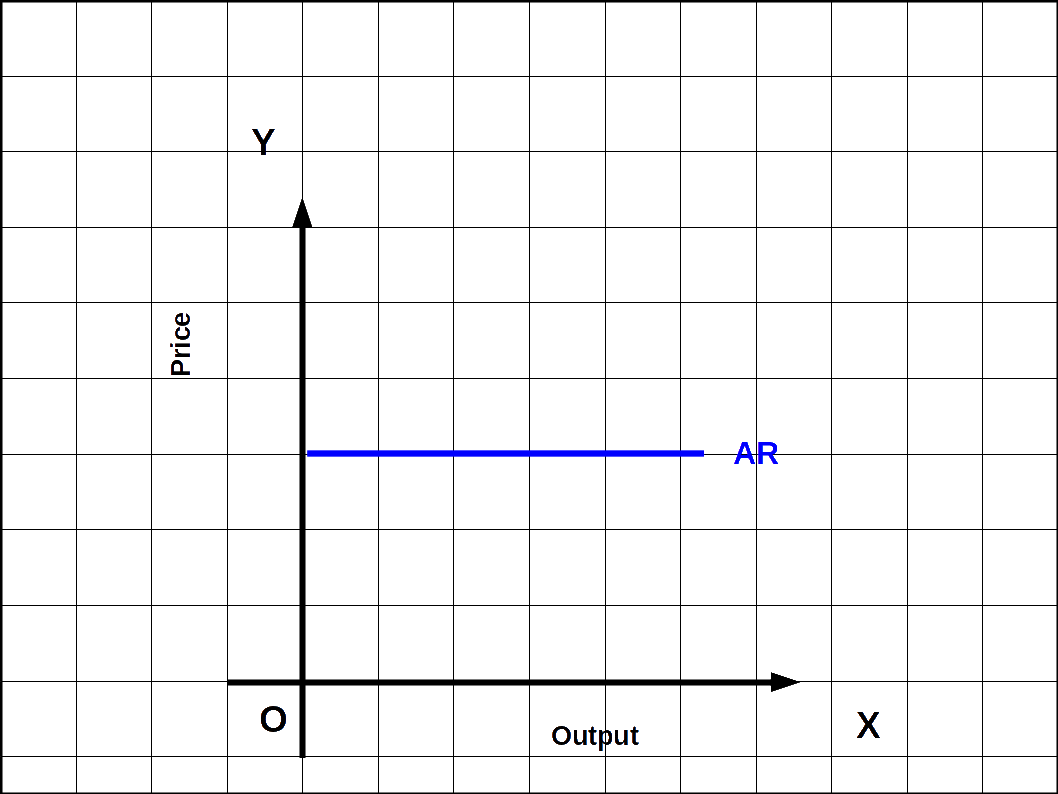 Answer:
Answer: - a ) Perfect competition
- b ) It is assumed that under perfect competition compared to the industry the share of each firm is meagre . No firm can influence the market supply . So even if a firm doubles the quantity supplied the market supply will not change . The price remains the same . So the AR or the demand curve is horizontal .
- Information about a firm is given in the following table .Find out the equilibrium level of output in terms of MC & MR . Give reasons for your answer .
Table 4.4 Output Total Revenue Total Cost 1 6 7 2 12 13 3 18 17 4 24 23 5 30 31
Answer: - A firm can sell any quantity of the output it produces at a given price . If so , what is the behaviour of mar ginal revenue and average revenue . Draw the two curves in a single diagram . Answer:
- Consider the following table .
Table 4.5 Output TFC TVC TC Price TR 0 500 — 500 15 — 50 500 500 1000 15 750 100 500 1000 1500 15 1500 200 500 2000 2500 15 3000 - a ) At which production level there will be no profit or loss to the producer ?
- b ) Comment on the profit and loss conditions as TC 1000 and TR 750 .
Answer: - a ) At the production level of 100 units of output the producer incurs 1500 TC and 1500 TR . So there will be no profit or loss to the producer
- b ) When TC = 1000
TR = 750
Loss TC – TR
= 1000 – 750 = 250 .
- How would each of the following affect the market supply curve for wheat ?
- a ) A new and improved technique is discovered .
- b ) The price of fertilizers falls .
- c ) The government offers new tax concessions to farmers .
- d ) A bad weather affects the crops .
Answer: - The following table shows the total cost schedule of a competitive firm . It is given that the price of the good is ₹ 10. Calculate the profit at each output level . Find the profit maximizing level of output .
Table 4.7 Output TC (₹) 0 5 1 15 2 22 3 27 4 31 5 38 6 49 7 63 8 81 9 101 10 123
Answer: - Differentiate between the shut – down point and break even point . Answer:
- Explain briefly break even point with the help of an example . Answer:
- Observe the following diagram .
Plot the break even point and shut down point .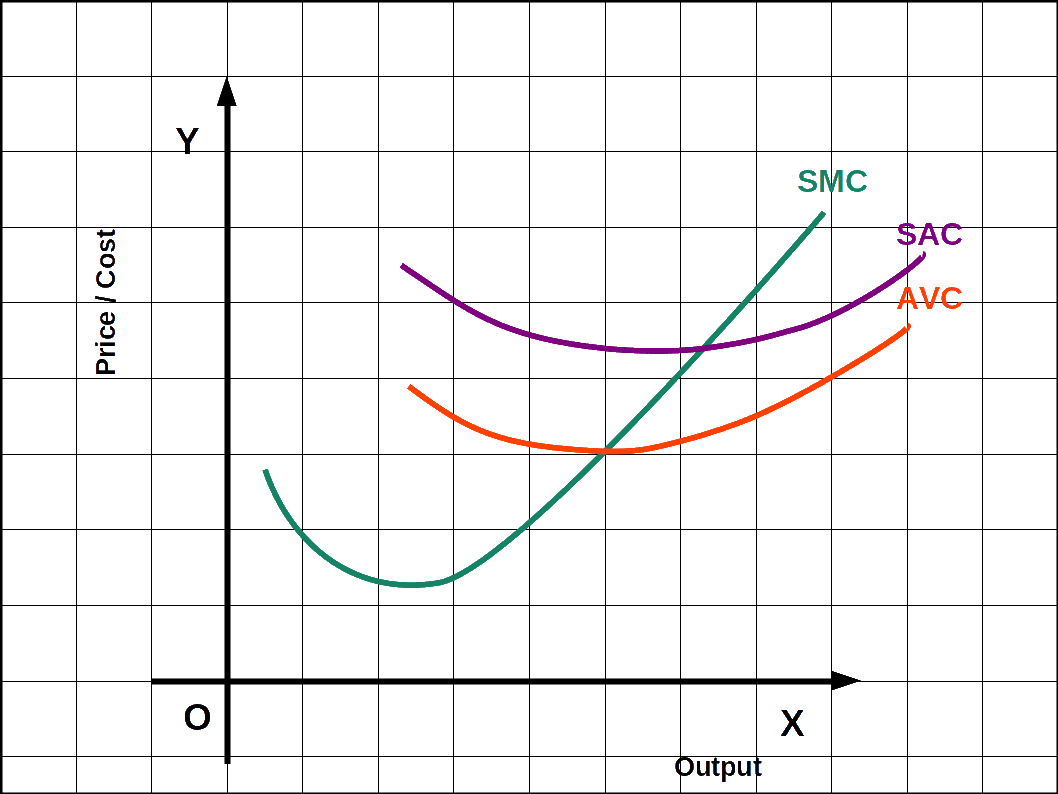 Answer:
Answer: - Complete the following tables and identify the market structure .
- a )
Table 4.10 Output (q) P TR AR MR 1 20 2 20 3 20 4 20 5 20 - b )
Table 4.11 Output (q) P TR AR MR 1 10 2 9.5 3 9 4 8.5 8 20
Answer: - a )
- a )
This market represents a perfectly competitive market because in this market , P = AR = MR .
Table 4.12 Output (q) P TR AR MR 1 20 20 20 20 2 20 40 20 20 3 20 60 20 20 4 20 80 20 20 5 20 100 20 20 - b )
This market represents a monopoly market . In this market AR and MR are different and AR > MR .
Table 4.13 Output (q) P TR AR MR 1 10 10 10 10 2 9.5 19 9.5 9 3 9 27 9 8 4 8.5 34 8.5 7 5 8 40 8 6 - At the market price of ₹ 10 , a firm supplies 4 units of orange . The market price rises to ₹ 30. The price elasticity of the firm’s supply is 1.25 . What quantity will the firm supply at the new price ? Answer:
- Suppose that the market demand in a perfectly competitve industry is given by ,
Qd = 7000-500 P
and the market supply function is given by
Qs = 4000 + 250 P
Find the market equilibrium price .
Answer: - Point out the features of perfect competition . Answer:
- i ) Large number of buyers and sellers
- ii ) Homogneous product
- iii ) Freedom of entry and exit
- iv ) Free movement of product and factors of production
- v ) Profit motive
- vi ) Perfect knowledge of market conditions
- vii ) Absense of transport cost
- Identify from the diagram below .
- a ) Shut down point and break even point
- b ) Distinguish between these two
- a ) Point ‘b’ is the break even point and point ‘a’ is the shut down point
- b ) Break down point shows a situation where a firm earns no profit or no loss . It is the point where AR = AC . Shut down point shows a situation where a firm is compelled to stop the production since it is not able to cover its variable cost . This is the situation where the firm’s P ≥ AVC .
- Identify the profit maximizing level of output from the diagram below . List out the condition for profit maximization .
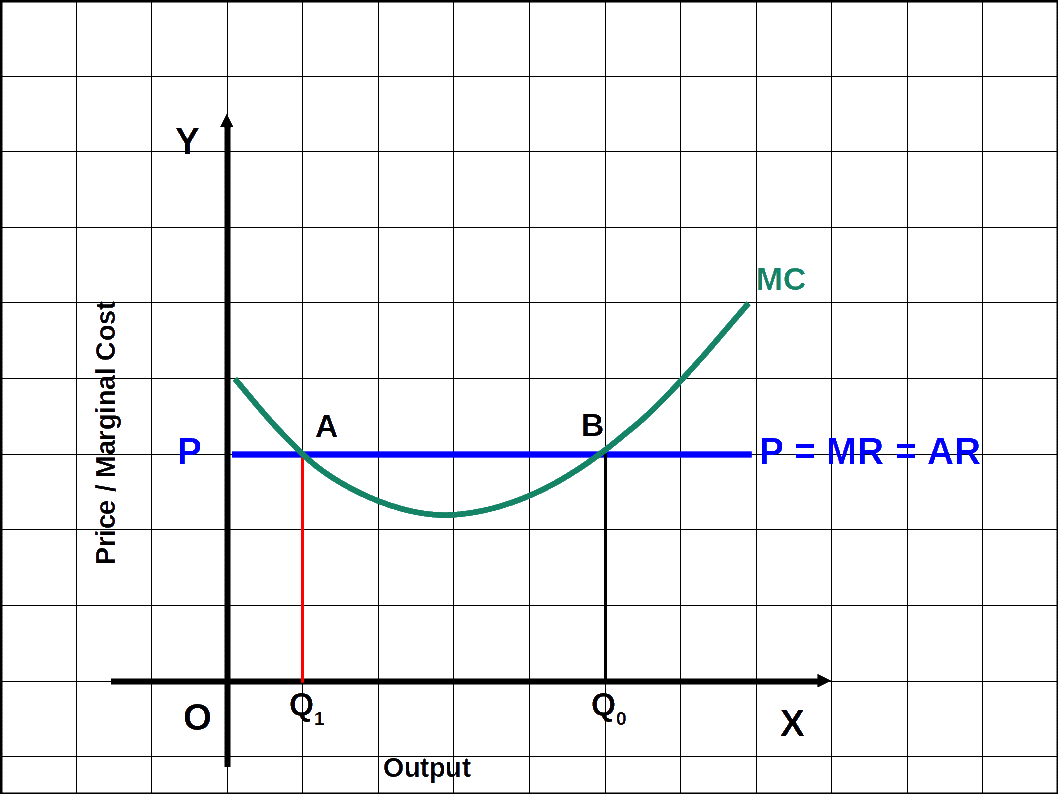 Answer:
Answer: - i ) MR = MC
- ii ) At the profit maximizing level of output MC is non decreasing , that is the slope of MC is positive
- iii ) P > AVC
- Match the commodities given below with the diagram . Justify your answer .
- a ) Coconut
- b ) Mobile phone
- a ) Diagram ‘A’ stands for mobile phones
- b ) Diagram ‘B’ stands for coconut
- The following table gives you certain information about a firm .
Table 4.14 Output Price TR MR 1 8 12 2 16 9 3 24 8 4 32 9 5 40 10 - i ) Find the price at which output is sold and identify the form market .
- ii ) Is this firm a price – taker or price – maker ? Give reasons .
- iii ) Find the firm’s equilibrium level of output in terms of MC & MR . Give reasons .
- iv ) Also find profit of the firm at this level of output .
Answer: - i ) Price – 8
- ii ) Price – taker , a firm has no influence on price de termination under perfect competition .
- iii ) Equilibrium quantity is 3. At this level of output MC = MR .
- iv ) Firm is at no profit – no loss condition . i.e. , he is at break even point .
- Prepare a seminar report on ‘ perfect competitive markets ‘ . Answer:
- a ) Profit Maximisation
- b ) Profit Maximisation in short run : Diagrammatic representation
- c ) Long run profit maximisation
- The diagram shows one of the short run equilibrium situations of a firm under perfect competition .
- a ) List out any four features of such market condition .
- b ) Identify the equilibrium situation of the firm profit , normal profit , loss diagrammatically . Show a situation in which the firm makes a profit .
- c ) With the help of a diagram explain the long run situation of a firm under perfect competition .
- a )
- i ) Large number of sellers
- ii ) Homegeneous product
- iii ) Firm is a price taker
- iv ) Free entry and exit
- b ) The firm is making a normal profit .
The firm produces ‘ oq ‘ level of output and charges a price ‘ op ‘ . The shaded area in the diagram shows profit .
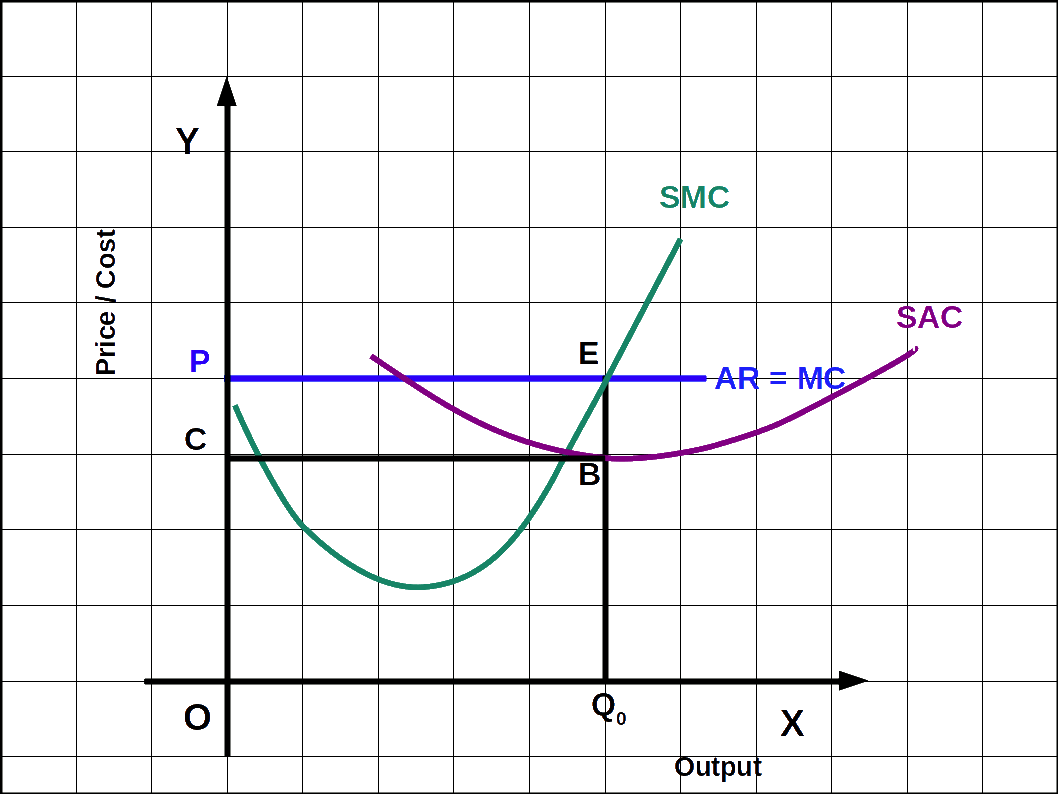
- c ) Firm under perfect competition in the long run makes only normal profit . This is because if firms are making profit , new entrants will be attracted into the industry . The price falls due to increase in supply and the extra profit will be taken away . If the firms are making loss some of them will leave the industry , price rises and the loss will be turned into profit . This is shown in the diagram below .
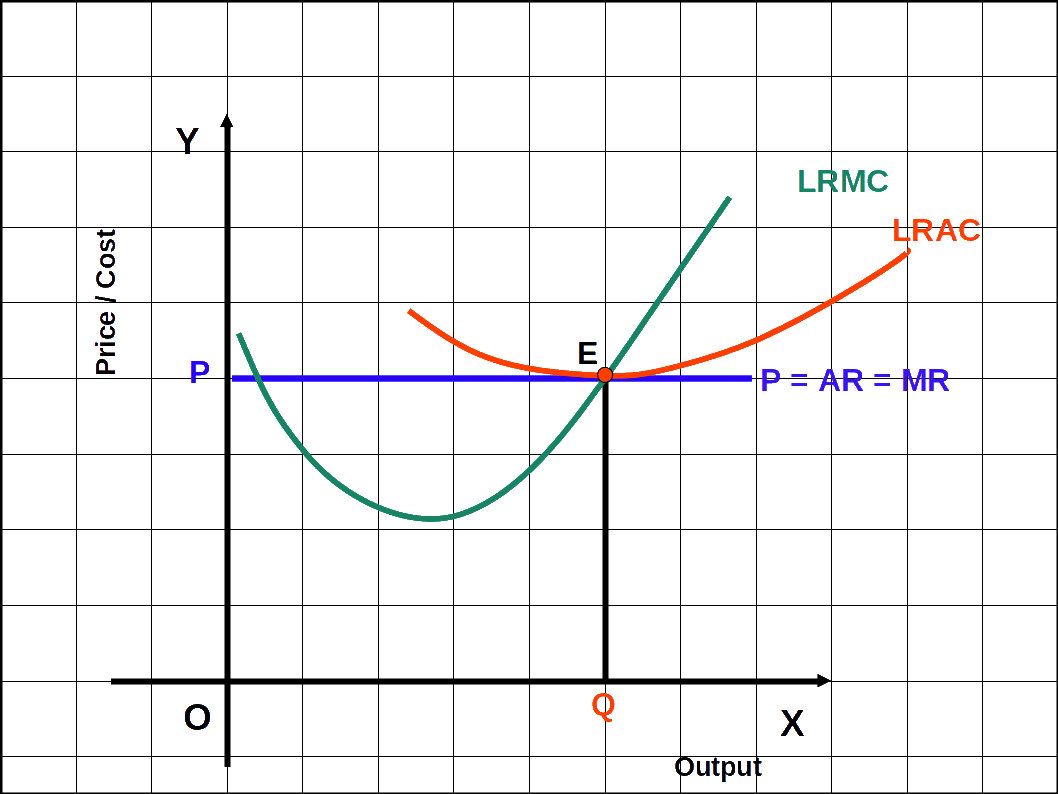
The firm under perfect competition in the long run will produce ‘ OQ ‘ level of output and charges a price ‘ OP ‘ .
- How are price and output determined under perfect competition in the short run ? Compare the profit of a firm in the short run and long run and bring out the difference . Give suitable diagram . Answer:
- i ) The price must be equal to MC ( P = MC )
- ii ) MC must be non – decreasing
- iii ) P ≥ AVC
- i ) The prices become equal to MC . At point E , the firm reaches equilibrium at the output level q0 ( MC = MR ) .
- ii ) At q0 MC is non – decreasing at point E.
- iii ) At point E , prices have become more than AVC ( P ≥ AVC at point E ) .
- Correct the following statements , if necessary :
- Statement I : Liquidity trap is the situation in which speculative demand for money is infinitely elastic .
- Statement II : The imposition of a unit tax shift the supply curve of a firm to the left .
- Stetement III : The profit level that is just cover the explicit cost and opportunity cost is super normal profit .
Answer: - Statement I : No correction
- Statement II : No correction
- Statement III : The profit level that is just cover the explicit cost and opportunity cost is normal profit .
- There are three identical firms in a market . The following table shows the supply schedule of a firm :
Table 4.15 Price (₹) Supply (Units) 0 0 1 1 2 2 3 4 4 6 5 8 6 10 - i ) Define market supply .
- ii ) Compute market supply schedule .
- iii ) Draw market supply curve .
Answer: - i ) The output level that firms in the market produce in aggregate , corresponding to different values of market prices .
- ii )
Table 4.16 Price Supply (1) Supply (2) Supply (3) Market Supply 0 0 0 0 0 1 1 1 1 3 2 2 2 2 6 3 4 4 4 12 4 6 6 6 18 5 8 8 8 24 6 10 10 10 30 - iii ) Draw a market supply curve that slopes upwards corresponding to the above values .
- At the market price of * 10 , a firm supplies 4 units of output . The market price increases to 30. The price elasticity of the firm’s supply is 1.25 . What quantity will the firm supply at the new price ? Answer:
- ” Any factor that affects a firm’s marginal cost curve is of course a determinant of its supply curve ” , there are three factors – determining the supply curve of a firm . Identify them . Answer:
- → Technical progress
- → Input prices
- → Unit tax
- Mr. Potti is a textile mill owner . He is facing challenges in production and marketing screnario . The situations he faced are given in column A and corresponding outcomes in marginal cost and supply of output are given in column B and C. Match A with B and C.
Table 4.17 A Situations
B MC Curve
C Supply Curve
a . Technical Progress Shifts right Shifts right b . Increase tax per unit Shifts left Shifts left c . Increase input price Shifts left Shifts left Shifts left
Answer: - Under perfect competition a firm’s profit inthe short run is maximized when 3 conditions are satisfied .
- a ) Discuss the 3 conditions .
- b ) From the following schedule , suggest profit maximizing level of output inthe short run if price .
- a )
- i ). MC must be equal to MR
- ii ). MC must cut MR from below
- iii ). Slope of MC must be greater than slope of MR
- b )
Table 4.20 Output (q) TC MC P TR MR 0 5 – – – – 1 15 10 10 10 10 2 22 7 10 20 10 3 27 5 10 30 10 4 31 4 10 40 10 5 38 7 10 50 10 6 48 10 10 60 10 7 63 15 10 70 10 8 81 15 10 80 10 9 101 20 10 90 10 10 123 22 10 100 10 - c ) Since MC = MR = 10 at 6th unit of output , the profit maximising level of output is 6 units .
- In the following diagram , at points E and E1 , MC and MR are equal . Among these , which point do you consider as producer’s equilibrium ? Justify your answer .
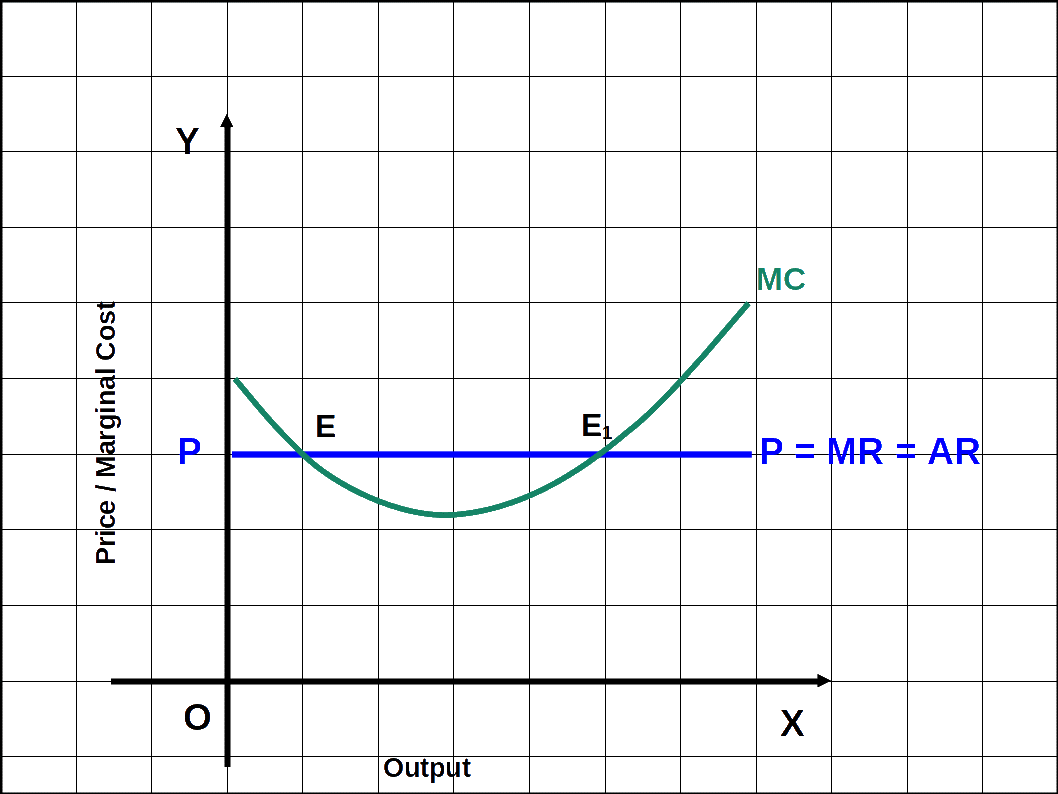 Answer:
Answer: - i) MC = MR
- ii ) MC must cut MR from below
- Firm ‘ A ‘ is operating under the condition of perfectly competitive market . Whether firm ‘ A ‘ is capable of maintaining abnormal profit in the long run ? Why ?
Hint : Long run equilibrium of a firm under perfect competition .
Answer: - Under perfect competition , a firm will not produce output level in cases under ( a ) P > MC and ( b ) P < MC . If so , what is the condition of profit maximising output in the shortrun . Give diagramatic illustration . ( Hint : Short run equilibrium of a firm under perfect competition ) . Answer:
- i ) There must be many firms acting independently . Each firm is small enough relative to the size of the market , so that a single firm’s decision to either stop production entirely or to produce to full capacity will not have any perceptible effect on market supply to cause a change in market price .
- ii ) Entry and exit from the market are free and frictionless for both the firms and consumers .
- iii ) The products offered for sale are homogeneous and divisible into small units .
- iv ) Buyers and sellers have perfect knowledge about the market conditions .
- v ) Price is determined by the impersonal market forces of supply and demand , and not by individual actions of buyers and sellers . The individual firm in such a market may be said to be a price – taker .
- vi ) There is perfect knowledge among consumers about the price at which goods are being sold in the market . Sellers thus cannot manipulate the commodity price and thereby exploit the consumer .
- vii ) There is perfect mobility of goods and factors of production among firms . Uniformity in factor prices is prevalent in the market .
- What are the conditions that are to be fulfilled for a firm to be in short run equillibrium under perfectly competitive market conditions ? Answer:
- ( i ) MC = MR , and
- ( ii ) the MC curve must cut the MR curve from below at the point of equality and then rise upwards .
- i ) All firms in an industry use homogeneous factors of production .
- ii ) Their costs are equal . Therefore , all cost curves are uniform .
- iii ) They use homogeneous plants so that their SAC curves are equal .
- iv ) All firms are of equal efficiency .
- v ) All firms sell their products at the same price determined by demand and supply of the industry so that the price of each firm is equal to AR = MR .
- A fruits seller sells 600 Kg . of grapes at market price of 40 per kg . When price increases to 50 per kg . he is ready to sell 750kg of grapes . Find out the price elasticity of supply . Answer:
- Will a profit – maximizing firm in a competitive market ever produce a positive level of output in the range where the marginal cost is falling ? Give an explanation with the help of a diagram . Answer:
- At the market price of ₹ 10 , a firm supplies 4 units of output . The market price increases to ₹ 30. The price elasticity of the firm’s supply is 1.25 . What quantity will the firm supply at the new price ? Answer:
- Distinguish :
- a ) Break even point
- b ) Shutdown point
Answer: - a ) The point on the supply curve at which a firm earns normal profit is called the break even point . The point of minimum average cost at which the supply curve cuts the LRAC curve is therefore the break even point of a firm .
- b ) In the short run the firm continues to produce as long as the price remains greater than or equal to the minimum of AVC . Therefore , along the supply curve as we move down , the last price – output combination at which the firm produces positive output is the point of minimum AVC where the SMC curve cuts the AVC curve . Below this , there will be no production . This point is called the short run shutdown point of the firm . In the long run , the shut down point is the minimum of LRAC curve .
- Graphically explain the short run equilibrium of the firm under Perfect Competition . Draw separate diagram depicting the following conditions :
- i ) The firm is earning super normal profit .
- ii ) The firm is earning only normal profit .
- iii ) The firm is incurring a loss .
Yes , I do agree to the statement that a firm cannot make super normal profit in the long run under perfect competition . This is because , freedom of entry will prevent super normal profit in the long run .
The point on the supply curve at which a firm eams normal profit is called the break even point . The point of minimum average cost at which the supply curve cuts the LRAC curve is therefore the break even point of a firm .
There is a major difference between the short run and long run price under perfect competition . In the short run , price should be equal to or greater than the minimum AVC . If the price falls below this level , the firm will shut down production . On the other hand , the long run price should be equal to or greater than the minimum AC . Below this level , the firm will shut down production .
In the long run a firm will produce output only when its price is at least equal to the average cost of production . Therefore , average cost curve represents the supply curve of the firm .
The supply curve of the firm slopes upward from left to right indicating a direct relationship between price and quantity supplied . When there is a technological progress , it will affect the supply . Now the firm will be in a position to produce and supply more output at the same price . Therefore the supply curve will shift towards the right side .
As the number of firms changes the market supply curve shifts . When the number of firms increases . the market supply curve shifts to the right . On the other hand , if the number of firms decreases , the market supply curve shifts to the left .
Shut down point refers to a situation where average revenue is equal to average variable cost . If the price fails to cover even average variable cost , firm will stop its production .
| Table 4.1 | ||
|---|---|---|
| Perfect Competition | Price Taker | |
| Monopoly | Price Maker | |
| Oligopoly | Cournot model | |
A. Total revenue curve
B. Average / Marginal revenue curve
| Table 4.3 | ||
|---|---|---|
| A | B | |
| Perfect Competition | Price Taker | |
| TR | Price × Quantity | |
| Profit | TR – TC | |
| Shut down point | Minimum point of AVC | |
| Supply curve of the firm | Rising portion of SMC | |
| Shift of supply curve | Rise in unit tax | |
A firm maximizes profit when the following three conditions are satisfied .
competition does not exist . This is because , it is rare to find the features of perfect competition especially the features like perfect knowledge , perfect mobility of factors and product , etc. What we really find in the world is monopolistic competition which is a mix of perfect competition and monopoly .
A firm under perfect competition in the short run will start supplying only if the price is equal to or greater than the short run average variable cost . Therefore , the rising part of the short run marginal cost which begins with the minimum SAVC is the supply curve of the firm in the short run .
If a unit tax is imposed , firm’s long run supply curve shifts to the left . It is shown in the following diagram .
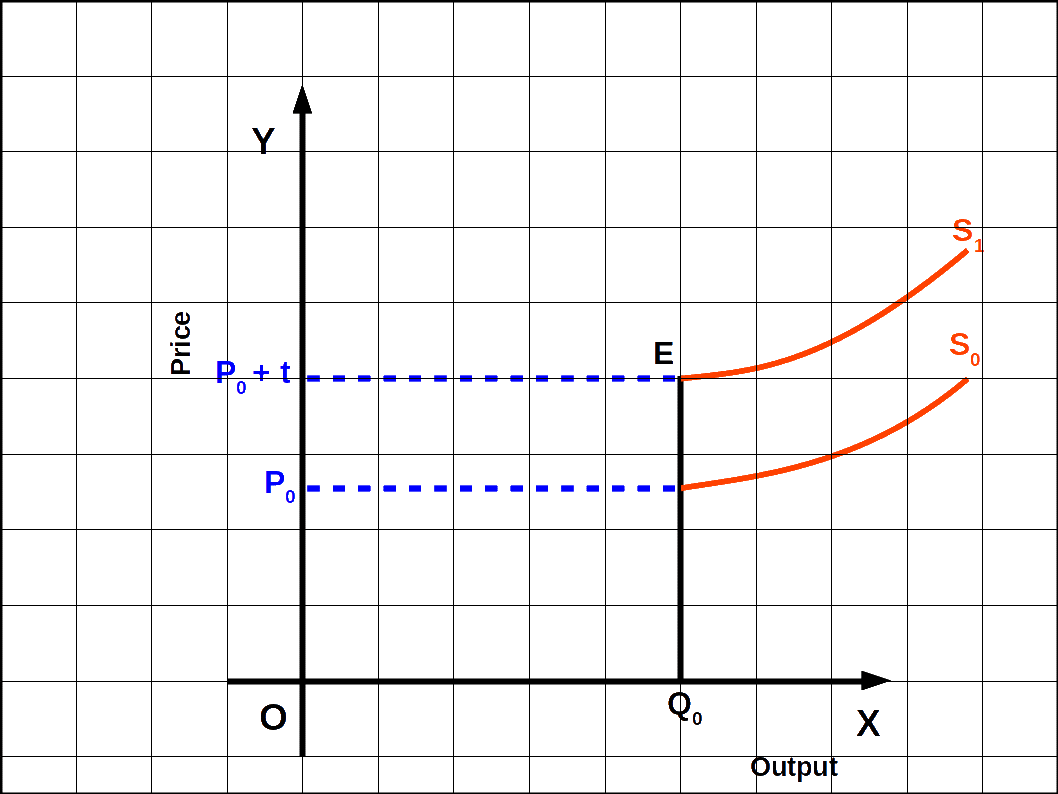
The factors affecting elasticity of supply are,
| Table 4.5 | ||||
|---|---|---|---|---|
| Output | TR | TC | MR | MC |
| 1 | 6 | 7 | 6 | 7 |
| 2 | 12 | 13 | 6 | 5 |
| 3 | 18 | 17 | 6 | 5 |
| 4 | 24 | 23 | 6 | 6 |
| 5 | 30 | 31 | 6 | 18 |
The demand curve facing the firm is perfectly elastic . At this condition AR = MR = Price .

| Table 4.6 | ||
|---|---|---|
| a ) A new and improved technique is discovered . | increase market supply | |
| b ) The price of fertilizers falls | increase market supply | |
| c ) The government offers new tax concessions to farmers . | increase market supply | |
| d ) A bad weather affects the crops . | decrease market supply | |
| Table 4.8 | |||
|---|---|---|---|
| Output (q) | TC (₹) | TR = Unit (q) × Price (P) | Profit (𝝅) = TR – TC |
| 0 | 5 | 0 × 10 = 0 | 0 – 5 = -5 |
| 1 | 15 | 1 × 10 = 10 | 10 – 15 = -5 |
| 2 | 22 | 2 × 10 = 20 | 20 – 22 = -2 |
| 3 | 27 | 3 × 10 = 30 | 30 – 27 = 3 |
| 4 | 31 | 4 × 10 = 40 | 40 – 31 = 9 |
| 5 | 38 | 5 × 10 = 50 | 50 – 38 = 12 |
| 6 | 48 | 6 × 10 = 60 | 60 – 49 = 11 |
| 7 | 63 | 7 × 10 = 70 | 70 – 63 = 7 |
| 8 | 81 | 8 × 10 = 80 | 80 – 81 = -1 |
| 9 | 101 | 9 × 10 = 90 | 90 – 101 = -11 |
| 10 | 123 | 10 × 10 = 100 | 100 – 123 = -23 |
Shut down point refers to a situation where average revenue is equal to average variable cost . In other words it is the minimum pint of AVC . On the other hand , break – evenpoint is the no – profit , no loss point . It is the point where TR = TC or AR = AC .
Break even point refers to a situation when total revenue is equal to total cost assuming a given selling price per unit of output .
TR = TC
This can be explained with the help of an example
| Table 4.9 | |||
|---|---|---|---|
| Output | TC | TR | Profit / Loss |
| 0 | 100 | 0 | Loss |
| 100 | 150 | 100 | Loss |
| 200 | 200 | 200 | Break even point |
| 300 | 250 | 300 | Profit |
| 400 | 300 | 400 | Profit |
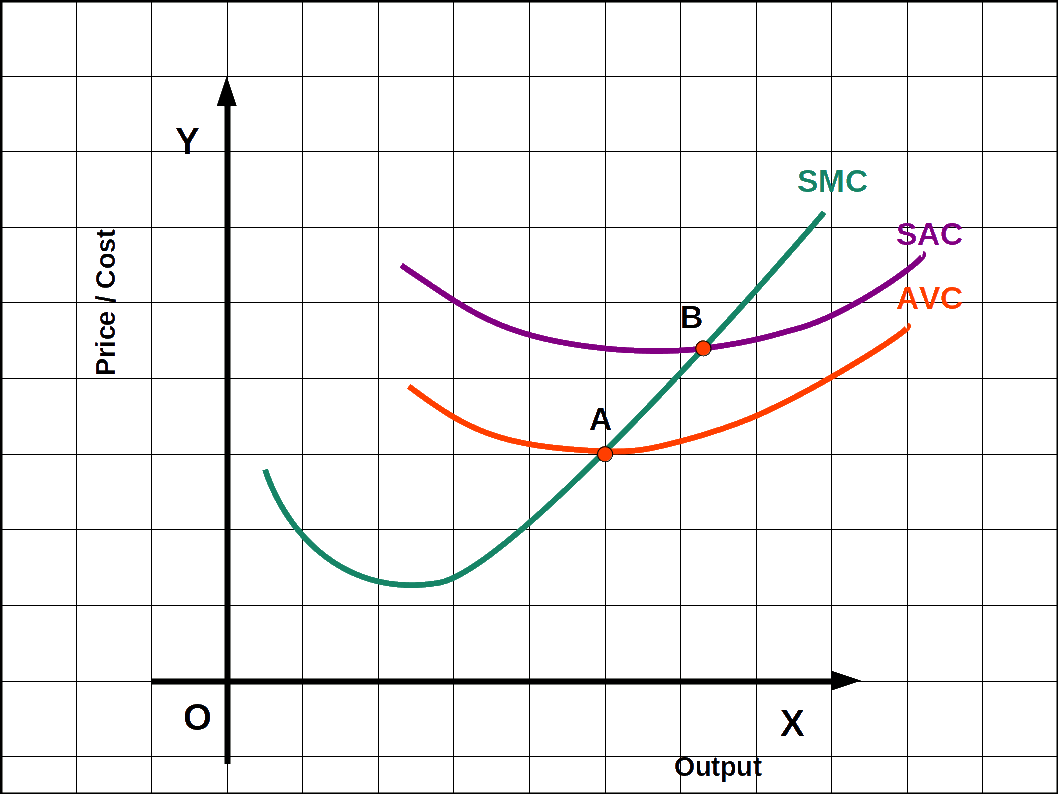
In the given example ,
P =10 Q = 4 P1 =30 es = 1.25 ΔP = 30 – 10 = 20 Applying these values in the formula , es = \( \mathbf{{{\frac{ΔQ}{ΔP}} }} \) × \( \mathbf{{{\frac{P}{Q}} }} \) we get, es = \( \mathbf{{{\frac{ΔQ}{ΔP}} }} \) × \( \mathbf{{{\frac{P}{Q}} }} \) 1.25 = \( \mathbf{{{\frac{ΔQ}{20}} }} \) × \( \mathbf{{{\frac{10}{4}} }} \) = \( \mathbf{{{\frac{ΔQ}{8}} }} \) ΔQ = 1.25 × 8 = 10 Therefore the new quantity , the firm will supply at the new price is ₹ 10 .Equilibrium is determined by the condition ,
Qd = Qs .
In this example ,
7000 – 500 P = 4000 + 250 P
7000 – 4000 = 250 P + 500 P
3000 = 750 P
P = \( \mathbf{{{\frac{3000}{750}} }} \) = 4
Features of perfect competion are pointed out below .
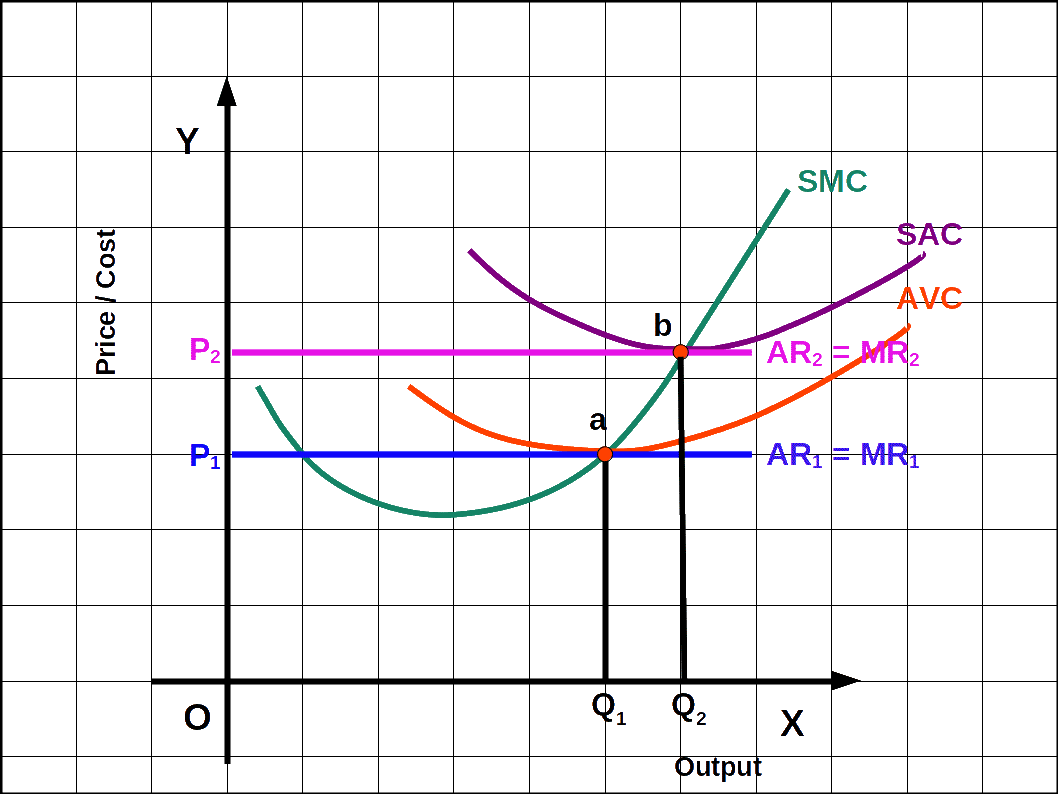 Answer:
Answer:
B is the profit maximizing level of output .
Conditions for profit maximisation are,
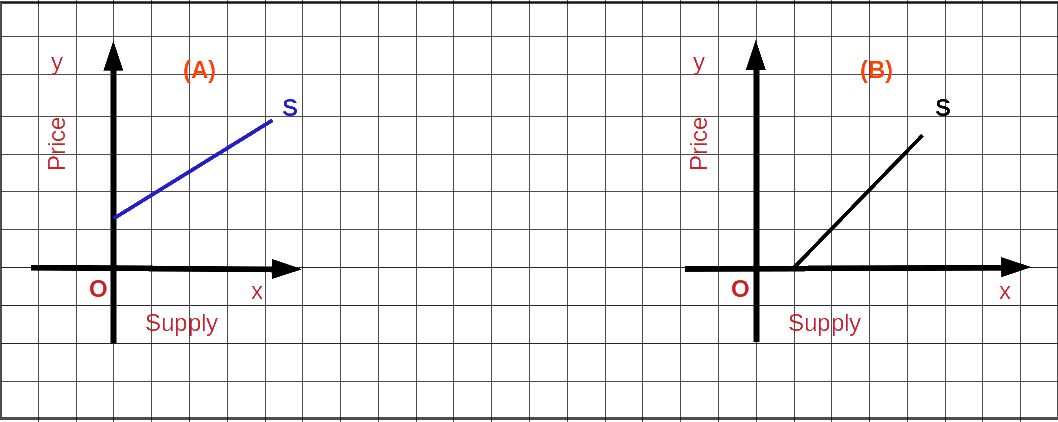 Answer:
Answer:
The supply of coconut can be price inelastic . This is because the producers cannot easily react to a change in the price of coconut . Years needed for a coconut tree to get mature and start to produce coconuts . It is an agricultural product . The producers cannot hold the stock of coconut for a longer duration .
Respected teachers and dear friends ,
The topic of my seminar paper is perfect competitive markets . The term market refers to all the places in which buyers and sellers are in contact with each other for the purchase and sale of any commodity or service . There are different kinds of markets based on their characteristics – say perfect competitive mar kets and noncompetitive markets .
Introduction :
Perfect competition is a market situation character ized by the existence of large number of buyers and sellers , homogeneous products , free mobility of fac tors of production , freedom of entry and exit , perfect knowledge of market conditions and absence of transportation costs .
Contents :
Conclusion :
Thus it can be concluded that perfect competition is a market structure characterized by complete absence rivalry among individual sellers . Sellers in the market do not hold any freedom of influencing market price . Therefore , they are known as price takers . However , it should be admitted that it is a rare form of market .
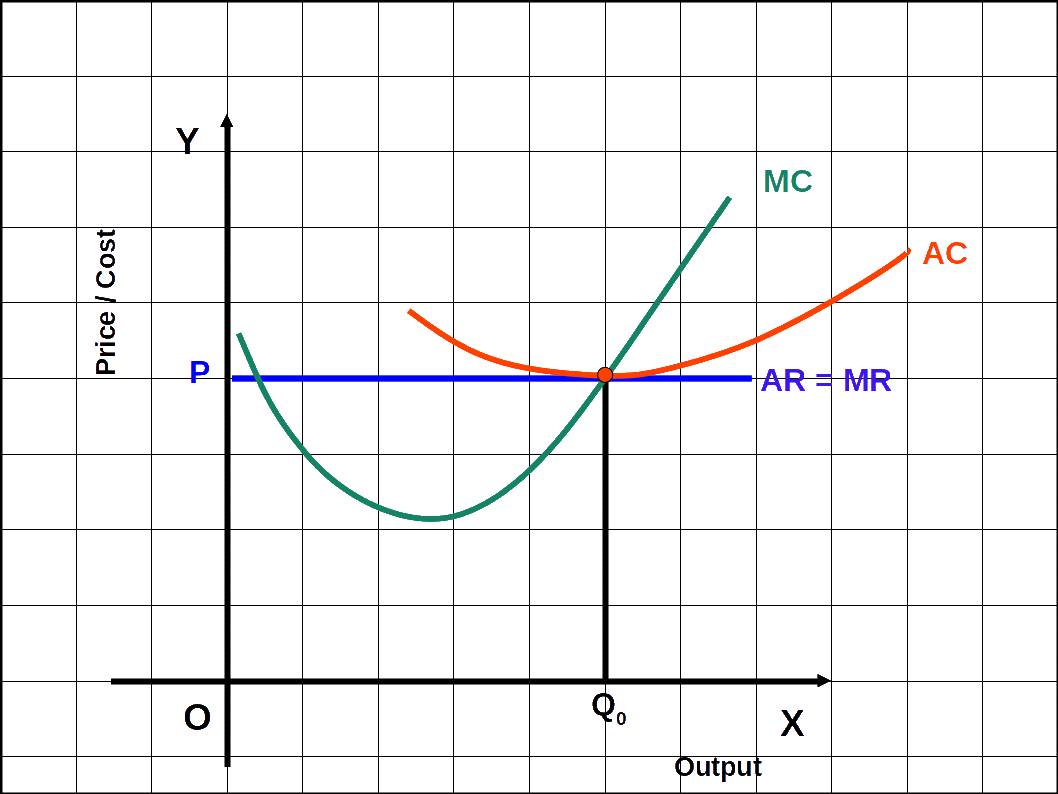
Under perfect competition , market determines the price – price taker and not price maker firms produce the output that maximises its profit – a firm may get ab normal profit or normal profit or loss in the short run only normal profit will prevail in the long run – due to free entry and exit – Draws separate diagram for short run and long run – explains price and output determina tion as well as profit in short run and long run .
PROFIT MAXIMIZATION IN SHORT – RUN : DIAGRAMMATIC REPRESENTATION
The profit maximizing condition of a firm in short – rn can be understood from the figure . All the three profit maximizing conditions of a firm in short run are sat isfied at point of output level q 0.
Short – run profit maximization
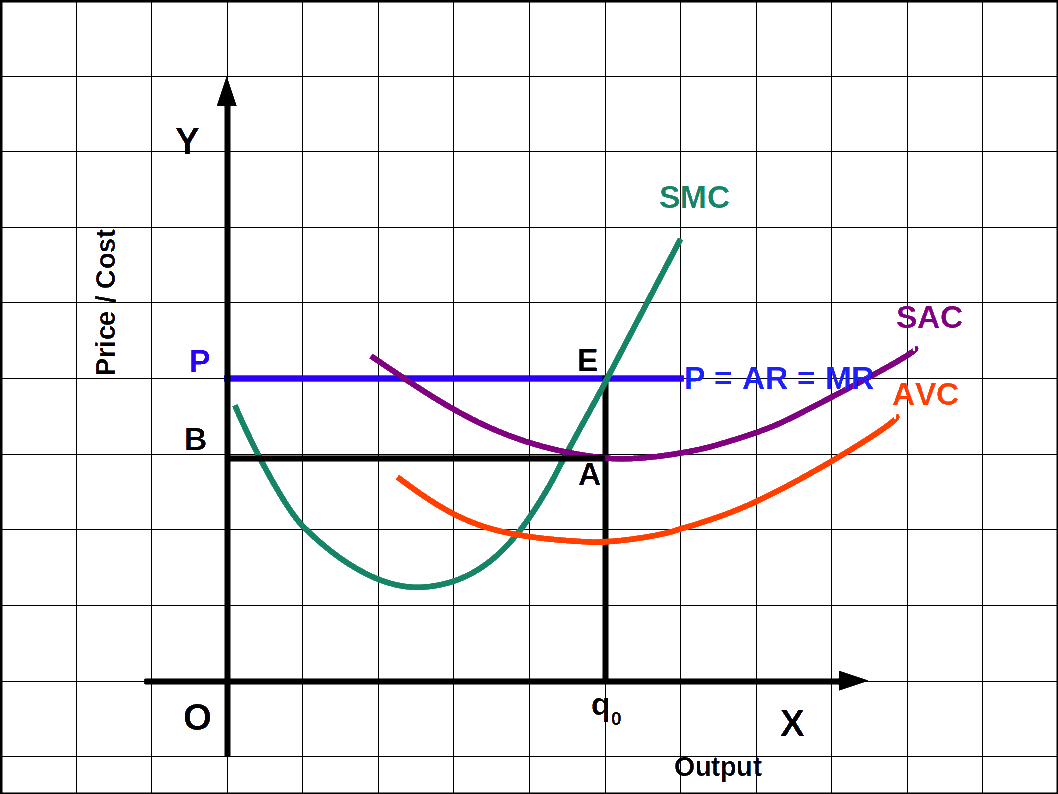
All the profit maximizing conditions are satisfied in the figure given above .
LONG RUN PROFIT MAXIMISATION
The profit maximization level of the firm is reached when the long run supply curve of the firm is that portion of LRMC curve which lies over and above the minimum point of LRAC curve ( P ≥ minimum of LRAC ) . The supply curve of a firm in the long run is the rising portion of minimum point of LRMC . It can be explained with the help of the following figure .
Long – run profit maximization

Price elasticity of supply ( ES ) = \( \mathbf{{{\frac{P}{q}} }} \) × \( \mathbf{{{\frac{Δq}{ΔP}} }} \) in the given situation ,
ES = 1.25
Δq = ?
Δp = 20
p =10
Q = 4
Applying these values in formula , we get ,
1.25 = \( \mathbf{{{\frac{10Δq}{4}} }} \) × \( \mathbf{{{\frac{20}{ΔP}} }} \)
1.25 = \( \mathbf{{{\frac{10\,Δq}{80}} }} \)100 = 10Δq
∴Δq = \( \mathbf{{{\frac{100}{10}} }} \) = 10
Since Δq = 10, firm’s new output = 4 + 10 = 14 .
determining the supply curve of a firm are :
| Table 4.18 | ||||
|---|---|---|---|---|
| A Situations |
B MC Curve |
C Supply Curve |
||
| a . Technical Progress | Shifts right | Shifts left | ||
| b . Increase tax per unit | Shifts left | Shifts right | ||
| c . Increase input price Shifts left | Shifts right | Shifts left | ||
| Table 4.19 | |||||
|---|---|---|---|---|---|
| Output (q) | TC | ||||
| 0 | 5 | ||||
| 1 | 15 | ||||
| 2 | 22 | ||||
| 3 | 27 | ||||
| 4 | 31 | ||||
| 5 | 38 | ||||
| 6 | 49 | ||||
| 7 | 63 | ||||
| 8 | 81 | ||||
| 9 | 101 | ||||
| 10 | 123 | ||||
In this diagram , producer’s equilibrium is at point E1 . This is because this point satisfies all the conditions of equilibrium . The conditions for attaining equilibrium are ,
Yes , I do agree to the statement that a firm cannot make super nomal profit in the long run under perfect competition . This is because ; freedom of entry will prevent super normal profit in the long run . We first determine the firm’s profit – maximizing out put level when the market price is greater than or equal to the minimum ( long run ) AC . This done , we determine the firm’s profit – maximizing output level when the market price is less than the minimum ( long run ) AC .
Case 1 : Price greater than or equal to the minimum LRAC
Case 2 : Price less than the minimum LRAC
Combining cases 1 and 2 , we reach an important conclusion . A firm’s long run supply curve is the rising part of the LRMC curve from and above the minimum LRAC together with zero output for all prices less than the minimum LRAC .
Perfect Competition – Short Run Equilibrium
In the model of price and output determination under perfectly competitive market conditions , price is determined by the impersonal market forces of supply and demand , and not by individual actions of buyers and sellers . The individual firm in such a market may be said to be a price – taker . Perfect competition is used by economists not so much as an attainable goal , but as a pure state against which all other markets can be measured .
For a market to be perfectly competitive , the following necessary conditions must , in general , prevail .
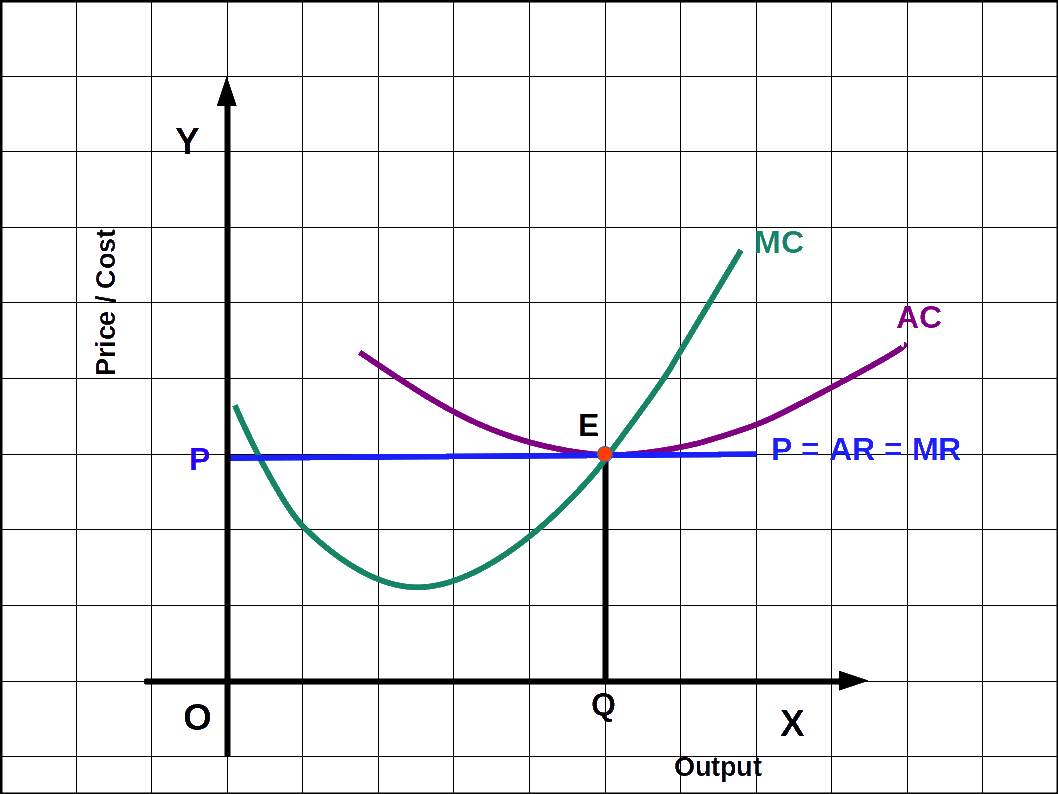
In the diagram the given price is P. Again the firm will produce the level of output for which MC = MR . This occurs at point E , giving a level of output of Q. Notice that at this point , AR = AC , so the firm is making normal profit .
So , in the short run , a perfectly competitive firm could be making super normal profit , or a loss , or just normal profit , depending on the given market price . Note that if the firm’s losses get too big in the short run ( i.e. AR < AVC ) then it will have to shut down .
A firm is in equilibrium when it has no tendency to change its level of output . It needs neither expansion nor contraction . It wants to earn maximum profits . In the words of A.W. Stonier and D.C. Hague , ” A firm will be in equilibrium when it is earning maximum money profits . ”
Equilibrium of the firm can be analysed in both short run and long – run periods . A firm can earn the maximum profits in the short run or may incur the minimum loss . But in the long run , it can earn only normal profit .
Short – run Equilibrium of the Firm : The short run is a period of time in which the firm can vary its output by changing the variable factors of production in order to earn maximum profits or to , incur minimum losses . The number of firms in the industry is fixed because neither the existing firms can leave nor new firms can enter it .
It’s Conditions : The firm is in equilibrium when it is eaming maximum profits as the difference between its total revenue and total cost .
For this , it essential that it must satisfy two conditions :
Marginal Revenue and Marginal Cost Approach : The short – run equilibrium of the firm can be explained with the help of the marginal analysis as well as with total cost – total revenue analysis . We first take the marginal analysis under identical cost conditions .
This analysis is based on the following assumptions :
Determination of Equilibrium :
Given these assumptions , suppose that price OP in the competitive market for the product of all the firms in the industry is determined by the equality of demand curve D and the supply curve S at point E in Figure 1 ( A ) so that their average revenue curve ( AR ) coincides with the marginal revenue curve ( MR ) .
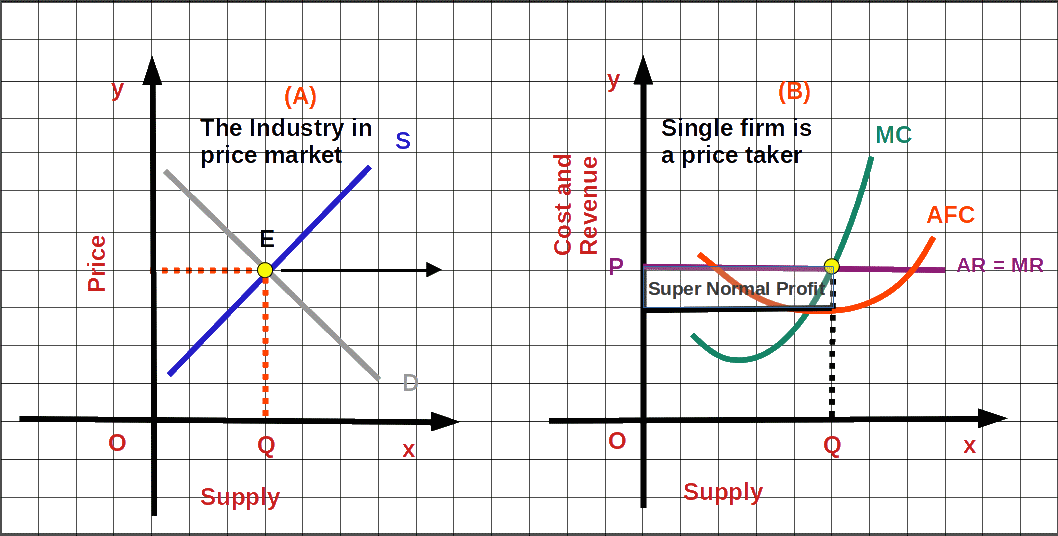
As Elasticity of supply ,
= \( \mathbf{{{\frac{Percentage\,change\,in\,quantity\,supplied}{Percentage\,change\,in\,price}} }} \)
\( \mathbf{{{\frac{P}{q}} }} \) × \( \mathbf{{{\frac{Δq}{ΔP}} }} \)
= \( \mathbf{{{\frac{40}{600}} }} \) × \( \mathbf{{{\frac{150}{10}} }} \)
= \( \mathbf{{{\frac{6000}{6000}} }} \) = 1
Here price elasticty of supply is one .
No , a profit maximising firm will not produce in the range where the marginal cost is falling . This is because , at this range , his profit is not maximised . So he fixes his level of out output at the point where marginal cost equals marginal revenue .
This can be explained with the help of a diagram .
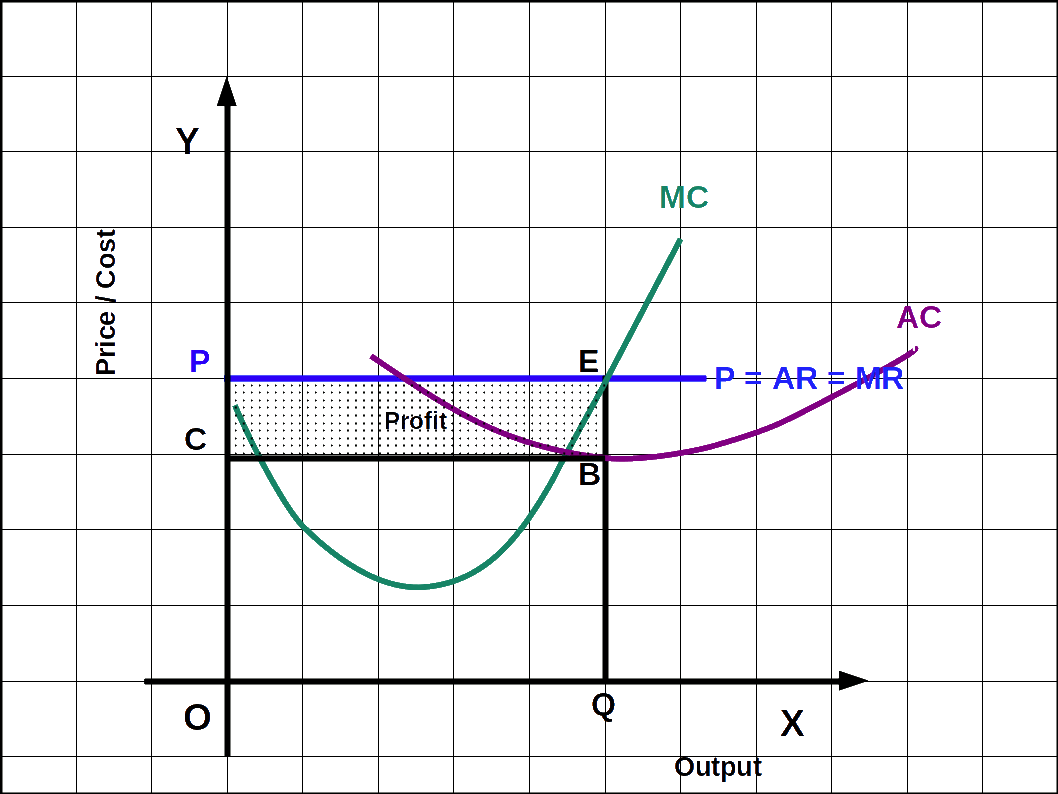
As per the diagram , if the firm fixes output at the range where MC is falling his profit will not be maximised . Being profit maximising firm , he goes on producing OQ level of output corresponding to the point where MC = MR . This is at the rising part of MC . So his profit is maximised as shown in shaded area .
Price elasticity of supply ( ES ) = \( \mathbf{{{\frac{Δq}{ΔP}} }} \) × \( \mathbf{{{\frac{P}{q}} }} \) in the given situatuon,
ES = 1.25
Δq = ?
Δp = 20
P = 10
q = 4
Applying these values in formula , we get ,
1.25 = \( \mathbf{{{\frac{Δq}{20}} }} \) × \( \mathbf{{{\frac{10}{4}} }} \)
1.25 = \( \mathbf{{{\frac{10Δq}{80}} }} \)
100 = 10Δq
∴Δq = \( \mathbf{{{\frac{100}{10}} }} \) = 10
Since Δq = 10 , Firm’s new output = 4 + 10 = 14
![]()

